Comprehensive Financial Analysis: LCT Valuation and Capital Structure
VerifiedAdded on 2020/03/16
|11
|2369
|34
Report
AI Summary
This report provides a detailed financial analysis of Living Cell Technologies (LCT). It begins with an executive summary outlining the report's objectives, which include valuing LCT's debt, shares, and cost of capital. The report then delves into debt valuation, noting LCT's lack of short and long-term debt compared to its industry peers. Share valuation is examined using the comparables approach and dividend growth model, highlighting the challenges in valuation due to LCT's financial performance. The cost of capital section focuses on Weighted Average Cost of Capital (WACC) and its application in investment decisions, while the market analysis compares LCT's financial performance with industry peers, and discusses the company's progress in treating Parkinson’s disease. The report concludes with a list of references used in the analysis. This report helps to understand the valuation and cost of capital concept thoroughly.
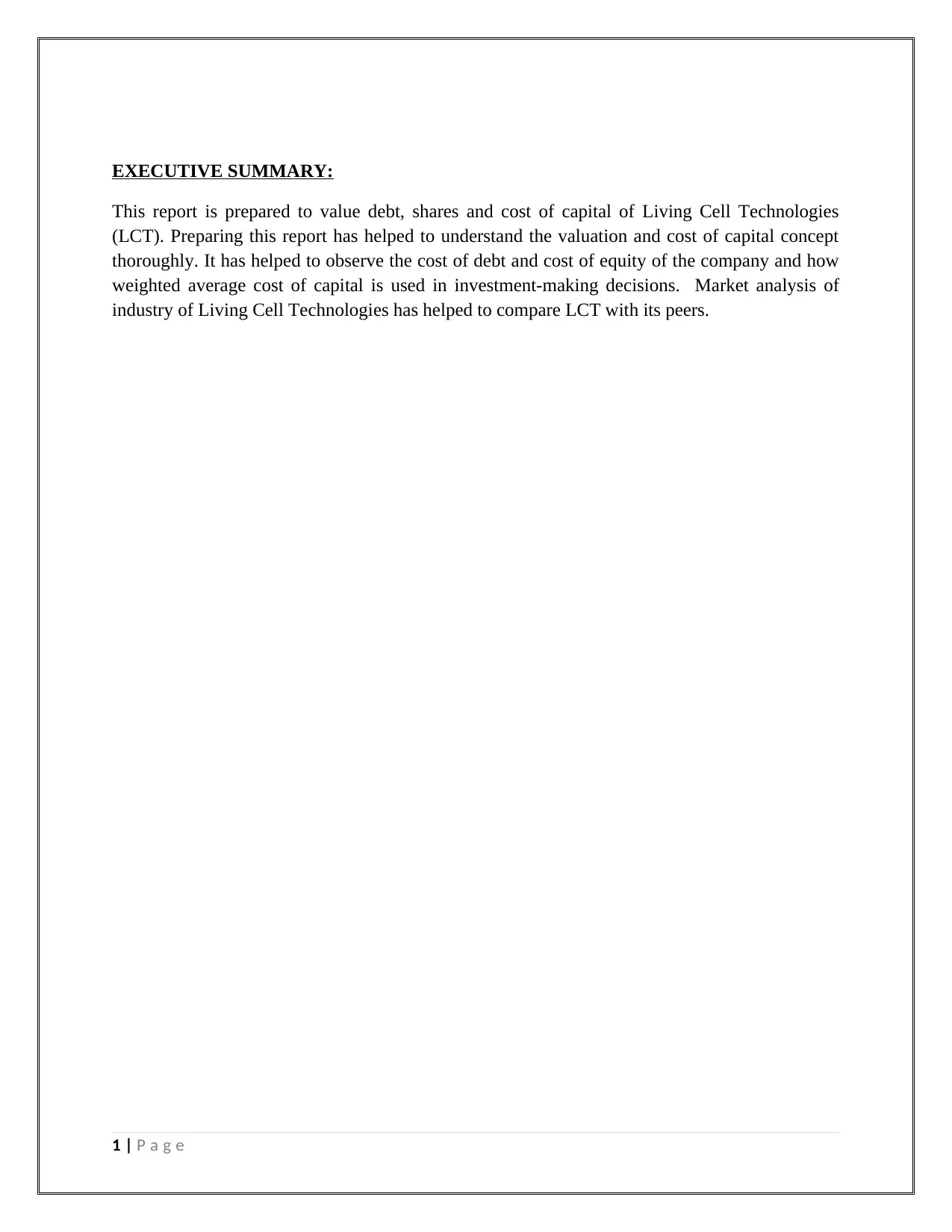
EXECUTIVE SUMMARY:
This report is prepared to value debt, shares and cost of capital of Living Cell Technologies
(LCT). Preparing this report has helped to understand the valuation and cost of capital concept
thoroughly. It has helped to observe the cost of debt and cost of equity of the company and how
weighted average cost of capital is used in investment-making decisions. Market analysis of
industry of Living Cell Technologies has helped to compare LCT with its peers.
1 | P a g e
This report is prepared to value debt, shares and cost of capital of Living Cell Technologies
(LCT). Preparing this report has helped to understand the valuation and cost of capital concept
thoroughly. It has helped to observe the cost of debt and cost of equity of the company and how
weighted average cost of capital is used in investment-making decisions. Market analysis of
industry of Living Cell Technologies has helped to compare LCT with its peers.
1 | P a g e
Paraphrase This Document
Need a fresh take? Get an instant paraphrase of this document with our AI Paraphraser
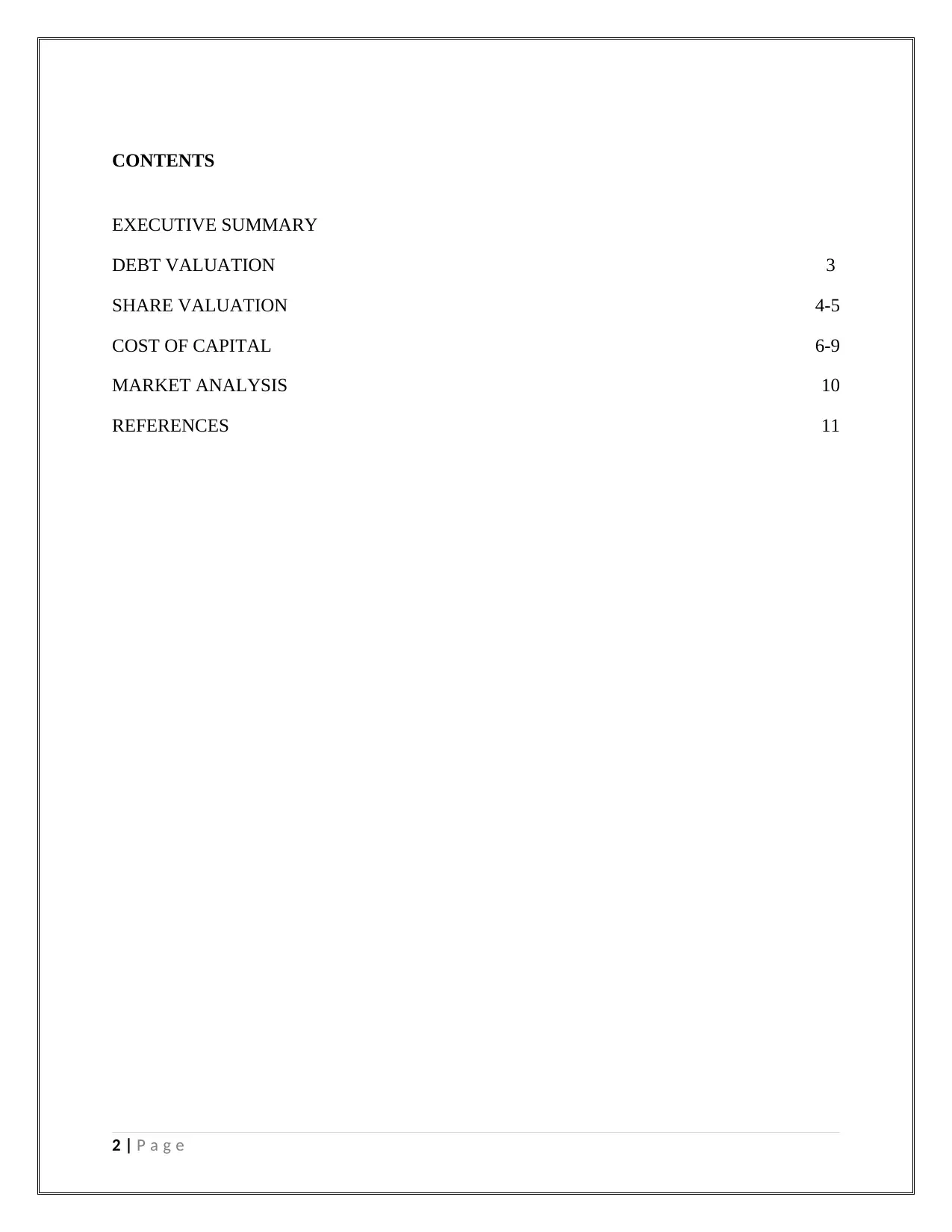
CONTENTS
EXECUTIVE SUMMARY
DEBT VALUATION 3
SHARE VALUATION 4-5
COST OF CAPITAL 6-9
MARKET ANALYSIS 10
REFERENCES 11
2 | P a g e
EXECUTIVE SUMMARY
DEBT VALUATION 3
SHARE VALUATION 4-5
COST OF CAPITAL 6-9
MARKET ANALYSIS 10
REFERENCES 11
2 | P a g e
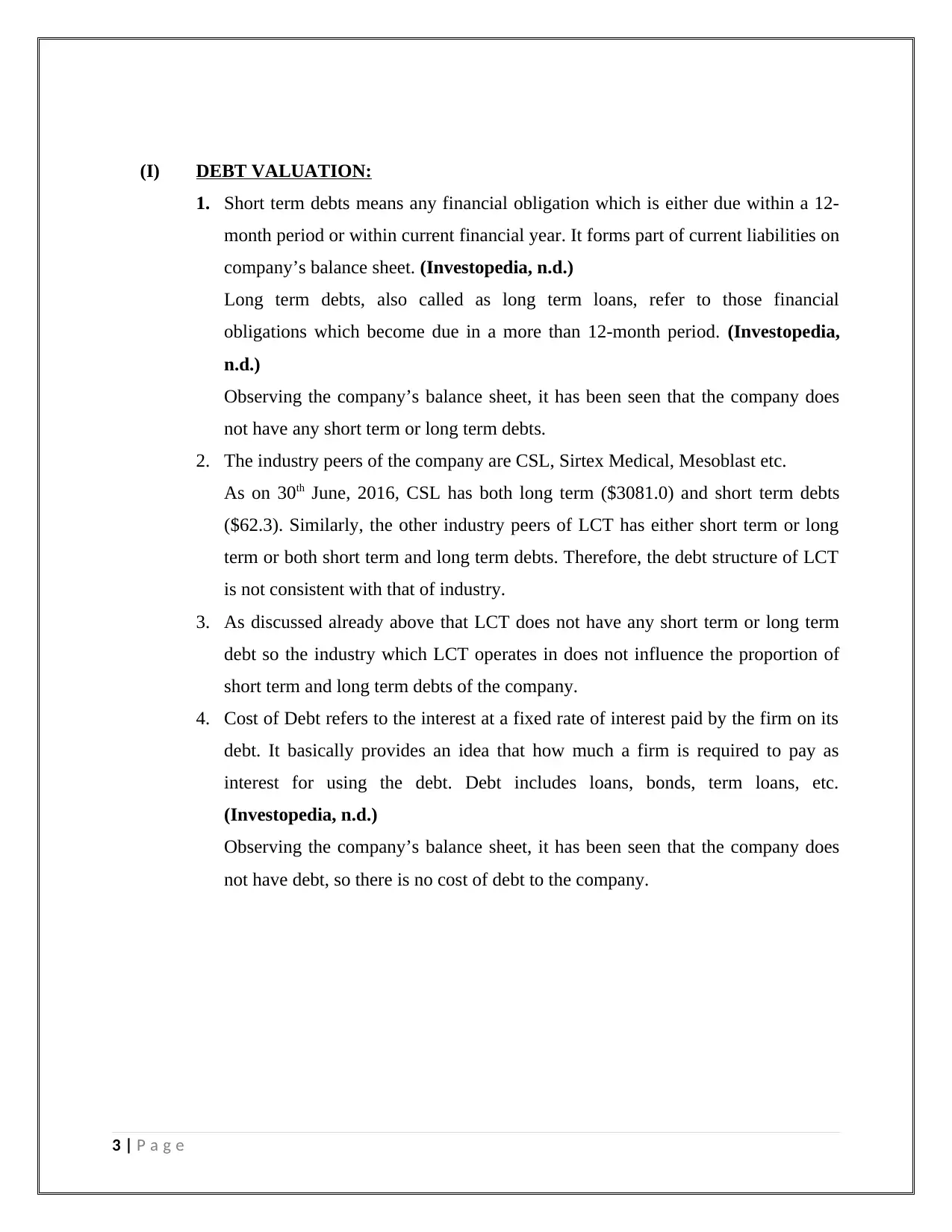
(I) DEBT VALUATION:
1. Short term debts means any financial obligation which is either due within a 12-
month period or within current financial year. It forms part of current liabilities on
company’s balance sheet. (Investopedia, n.d.)
Long term debts, also called as long term loans, refer to those financial
obligations which become due in a more than 12-month period. (Investopedia,
n.d.)
Observing the company’s balance sheet, it has been seen that the company does
not have any short term or long term debts.
2. The industry peers of the company are CSL, Sirtex Medical, Mesoblast etc.
As on 30th June, 2016, CSL has both long term ($3081.0) and short term debts
($62.3). Similarly, the other industry peers of LCT has either short term or long
term or both short term and long term debts. Therefore, the debt structure of LCT
is not consistent with that of industry.
3. As discussed already above that LCT does not have any short term or long term
debt so the industry which LCT operates in does not influence the proportion of
short term and long term debts of the company.
4. Cost of Debt refers to the interest at a fixed rate of interest paid by the firm on its
debt. It basically provides an idea that how much a firm is required to pay as
interest for using the debt. Debt includes loans, bonds, term loans, etc.
(Investopedia, n.d.)
Observing the company’s balance sheet, it has been seen that the company does
not have debt, so there is no cost of debt to the company.
3 | P a g e
1. Short term debts means any financial obligation which is either due within a 12-
month period or within current financial year. It forms part of current liabilities on
company’s balance sheet. (Investopedia, n.d.)
Long term debts, also called as long term loans, refer to those financial
obligations which become due in a more than 12-month period. (Investopedia,
n.d.)
Observing the company’s balance sheet, it has been seen that the company does
not have any short term or long term debts.
2. The industry peers of the company are CSL, Sirtex Medical, Mesoblast etc.
As on 30th June, 2016, CSL has both long term ($3081.0) and short term debts
($62.3). Similarly, the other industry peers of LCT has either short term or long
term or both short term and long term debts. Therefore, the debt structure of LCT
is not consistent with that of industry.
3. As discussed already above that LCT does not have any short term or long term
debt so the industry which LCT operates in does not influence the proportion of
short term and long term debts of the company.
4. Cost of Debt refers to the interest at a fixed rate of interest paid by the firm on its
debt. It basically provides an idea that how much a firm is required to pay as
interest for using the debt. Debt includes loans, bonds, term loans, etc.
(Investopedia, n.d.)
Observing the company’s balance sheet, it has been seen that the company does
not have debt, so there is no cost of debt to the company.
3 | P a g e
⊘ This is a preview!⊘
Do you want full access?
Subscribe today to unlock all pages.

Trusted by 1+ million students worldwide
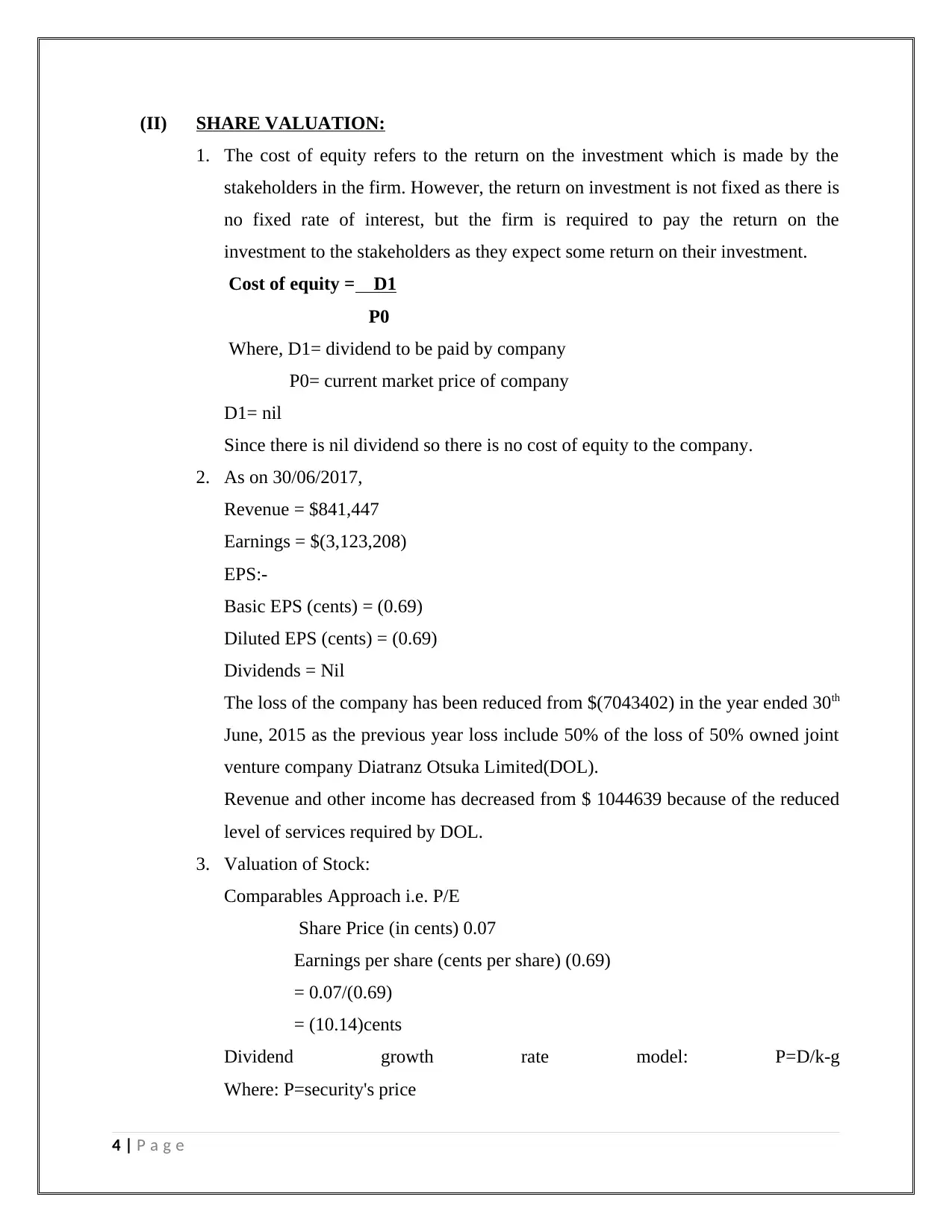
(II) SHARE VALUATION:
1. The cost of equity refers to the return on the investment which is made by the
stakeholders in the firm. However, the return on investment is not fixed as there is
no fixed rate of interest, but the firm is required to pay the return on the
investment to the stakeholders as they expect some return on their investment.
Cost of equity = D1
P0
Where, D1= dividend to be paid by company
P0= current market price of company
D1= nil
Since there is nil dividend so there is no cost of equity to the company.
2. As on 30/06/2017,
Revenue = $841,447
Earnings = $(3,123,208)
EPS:-
Basic EPS (cents) = (0.69)
Diluted EPS (cents) = (0.69)
Dividends = Nil
The loss of the company has been reduced from $(7043402) in the year ended 30th
June, 2015 as the previous year loss include 50% of the loss of 50% owned joint
venture company Diatranz Otsuka Limited(DOL).
Revenue and other income has decreased from $ 1044639 because of the reduced
level of services required by DOL.
3. Valuation of Stock:
Comparables Approach i.e. P/E
Share Price (in cents) 0.07
Earnings per share (cents per share) (0.69)
= 0.07/(0.69)
= (10.14)cents
Dividend growth rate model: P=D/k-g
Where: P=security's price
4 | P a g e
1. The cost of equity refers to the return on the investment which is made by the
stakeholders in the firm. However, the return on investment is not fixed as there is
no fixed rate of interest, but the firm is required to pay the return on the
investment to the stakeholders as they expect some return on their investment.
Cost of equity = D1
P0
Where, D1= dividend to be paid by company
P0= current market price of company
D1= nil
Since there is nil dividend so there is no cost of equity to the company.
2. As on 30/06/2017,
Revenue = $841,447
Earnings = $(3,123,208)
EPS:-
Basic EPS (cents) = (0.69)
Diluted EPS (cents) = (0.69)
Dividends = Nil
The loss of the company has been reduced from $(7043402) in the year ended 30th
June, 2015 as the previous year loss include 50% of the loss of 50% owned joint
venture company Diatranz Otsuka Limited(DOL).
Revenue and other income has decreased from $ 1044639 because of the reduced
level of services required by DOL.
3. Valuation of Stock:
Comparables Approach i.e. P/E
Share Price (in cents) 0.07
Earnings per share (cents per share) (0.69)
= 0.07/(0.69)
= (10.14)cents
Dividend growth rate model: P=D/k-g
Where: P=security's price
4 | P a g e
Paraphrase This Document
Need a fresh take? Get an instant paraphrase of this document with our AI Paraphraser
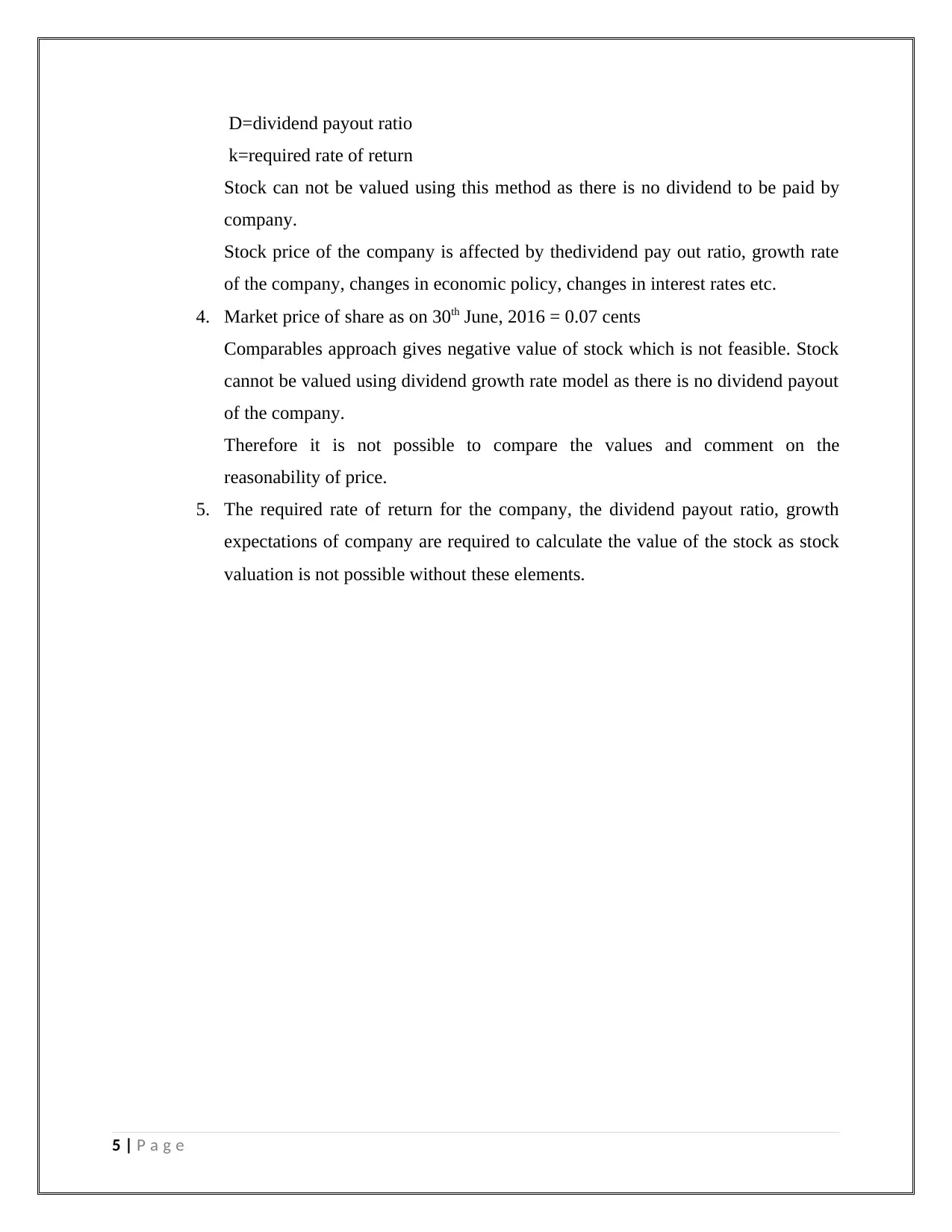
D=dividend payout ratio
k=required rate of return
Stock can not be valued using this method as there is no dividend to be paid by
company.
Stock price of the company is affected by thedividend pay out ratio, growth rate
of the company, changes in economic policy, changes in interest rates etc.
4. Market price of share as on 30th June, 2016 = 0.07 cents
Comparables approach gives negative value of stock which is not feasible. Stock
cannot be valued using dividend growth rate model as there is no dividend payout
of the company.
Therefore it is not possible to compare the values and comment on the
reasonability of price.
5. The required rate of return for the company, the dividend payout ratio, growth
expectations of company are required to calculate the value of the stock as stock
valuation is not possible without these elements.
5 | P a g e
k=required rate of return
Stock can not be valued using this method as there is no dividend to be paid by
company.
Stock price of the company is affected by thedividend pay out ratio, growth rate
of the company, changes in economic policy, changes in interest rates etc.
4. Market price of share as on 30th June, 2016 = 0.07 cents
Comparables approach gives negative value of stock which is not feasible. Stock
cannot be valued using dividend growth rate model as there is no dividend payout
of the company.
Therefore it is not possible to compare the values and comment on the
reasonability of price.
5. The required rate of return for the company, the dividend payout ratio, growth
expectations of company are required to calculate the value of the stock as stock
valuation is not possible without these elements.
5 | P a g e
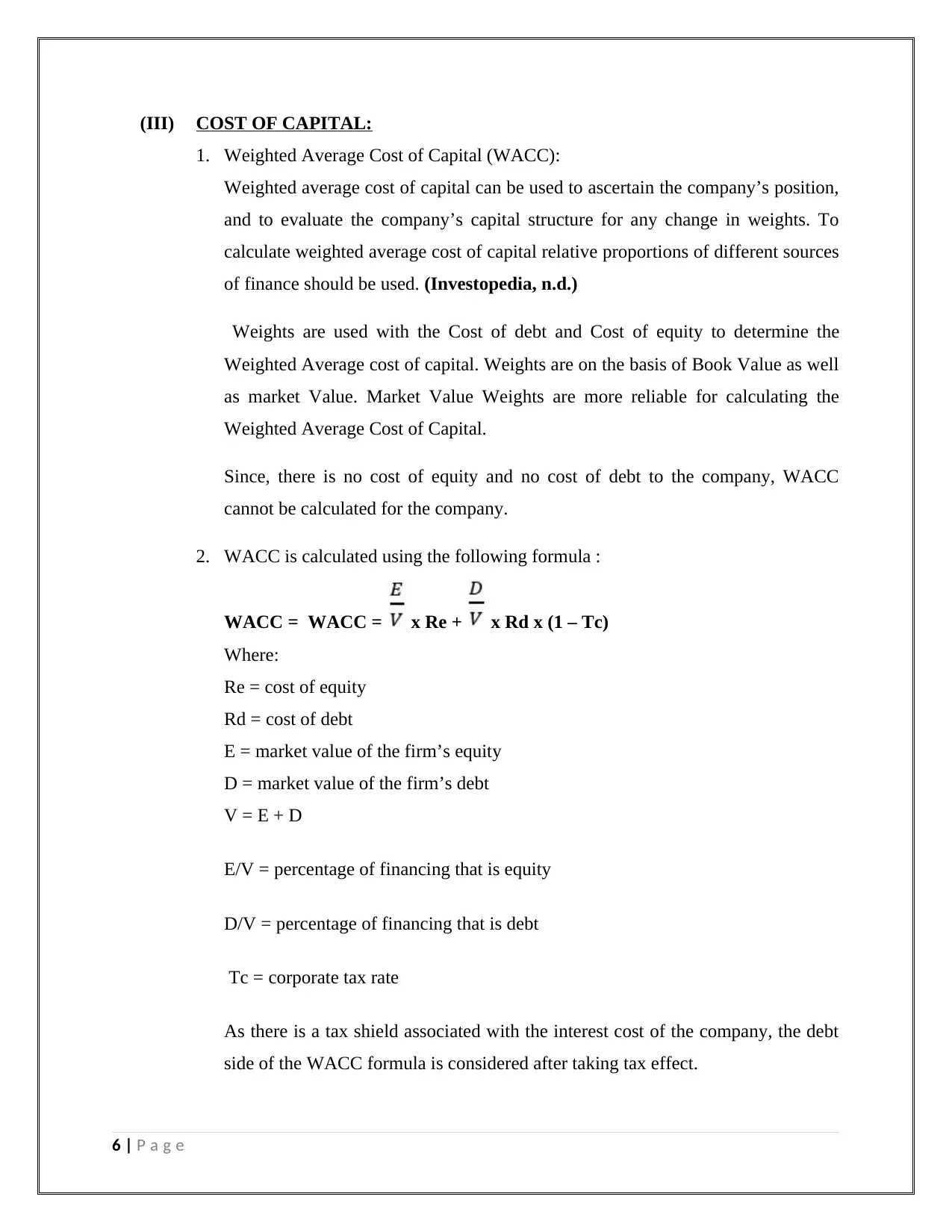
(III) COST OF CAPITAL:
1. Weighted Average Cost of Capital (WACC):
Weighted average cost of capital can be used to ascertain the company’s position,
and to evaluate the company’s capital structure for any change in weights. To
calculate weighted average cost of capital relative proportions of different sources
of finance should be used. (Investopedia, n.d.)
Weights are used with the Cost of debt and Cost of equity to determine the
Weighted Average cost of capital. Weights are on the basis of Book Value as well
as market Value. Market Value Weights are more reliable for calculating the
Weighted Average Cost of Capital.
Since, there is no cost of equity and no cost of debt to the company, WACC
cannot be calculated for the company.
2. WACC is calculated using the following formula :
WACC = WACC = x Re + x Rd x (1 – Tc)
Where:
Re = cost of equity
Rd = cost of debt
E = market value of the firm’s equity
D = market value of the firm’s debt
V = E + D
E/V = percentage of financing that is equity
D/V = percentage of financing that is debt
Tc = corporate tax rate
As there is a tax shield associated with the interest cost of the company, the debt
side of the WACC formula is considered after taking tax effect.
6 | P a g e
1. Weighted Average Cost of Capital (WACC):
Weighted average cost of capital can be used to ascertain the company’s position,
and to evaluate the company’s capital structure for any change in weights. To
calculate weighted average cost of capital relative proportions of different sources
of finance should be used. (Investopedia, n.d.)
Weights are used with the Cost of debt and Cost of equity to determine the
Weighted Average cost of capital. Weights are on the basis of Book Value as well
as market Value. Market Value Weights are more reliable for calculating the
Weighted Average Cost of Capital.
Since, there is no cost of equity and no cost of debt to the company, WACC
cannot be calculated for the company.
2. WACC is calculated using the following formula :
WACC = WACC = x Re + x Rd x (1 – Tc)
Where:
Re = cost of equity
Rd = cost of debt
E = market value of the firm’s equity
D = market value of the firm’s debt
V = E + D
E/V = percentage of financing that is equity
D/V = percentage of financing that is debt
Tc = corporate tax rate
As there is a tax shield associated with the interest cost of the company, the debt
side of the WACC formula is considered after taking tax effect.
6 | P a g e
⊘ This is a preview!⊘
Do you want full access?
Subscribe today to unlock all pages.

Trusted by 1+ million students worldwide
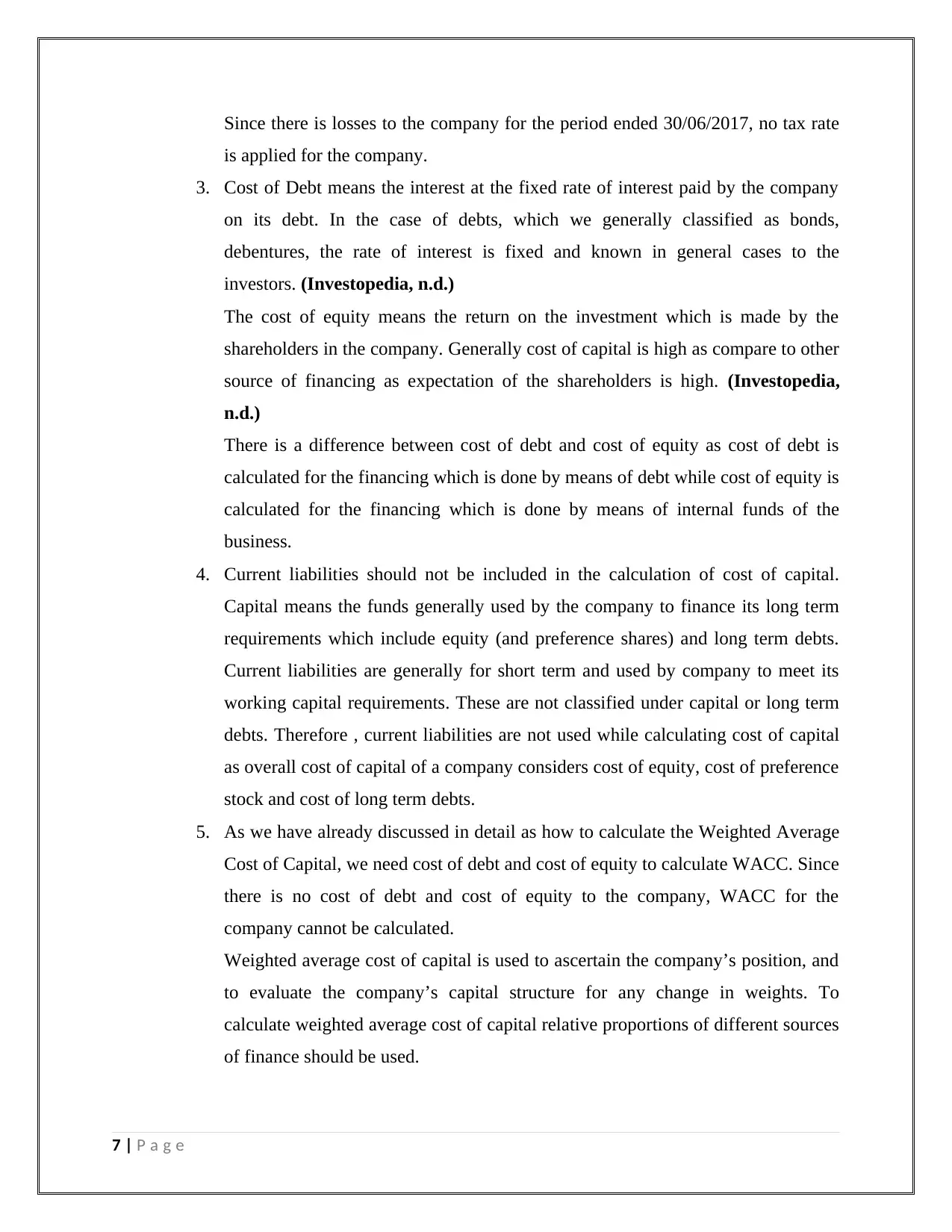
Since there is losses to the company for the period ended 30/06/2017, no tax rate
is applied for the company.
3. Cost of Debt means the interest at the fixed rate of interest paid by the company
on its debt. In the case of debts, which we generally classified as bonds,
debentures, the rate of interest is fixed and known in general cases to the
investors. (Investopedia, n.d.)
The cost of equity means the return on the investment which is made by the
shareholders in the company. Generally cost of capital is high as compare to other
source of financing as expectation of the shareholders is high. (Investopedia,
n.d.)
There is a difference between cost of debt and cost of equity as cost of debt is
calculated for the financing which is done by means of debt while cost of equity is
calculated for the financing which is done by means of internal funds of the
business.
4. Current liabilities should not be included in the calculation of cost of capital.
Capital means the funds generally used by the company to finance its long term
requirements which include equity (and preference shares) and long term debts.
Current liabilities are generally for short term and used by company to meet its
working capital requirements. These are not classified under capital or long term
debts. Therefore , current liabilities are not used while calculating cost of capital
as overall cost of capital of a company considers cost of equity, cost of preference
stock and cost of long term debts.
5. As we have already discussed in detail as how to calculate the Weighted Average
Cost of Capital, we need cost of debt and cost of equity to calculate WACC. Since
there is no cost of debt and cost of equity to the company, WACC for the
company cannot be calculated.
Weighted average cost of capital is used to ascertain the company’s position, and
to evaluate the company’s capital structure for any change in weights. To
calculate weighted average cost of capital relative proportions of different sources
of finance should be used.
7 | P a g e
is applied for the company.
3. Cost of Debt means the interest at the fixed rate of interest paid by the company
on its debt. In the case of debts, which we generally classified as bonds,
debentures, the rate of interest is fixed and known in general cases to the
investors. (Investopedia, n.d.)
The cost of equity means the return on the investment which is made by the
shareholders in the company. Generally cost of capital is high as compare to other
source of financing as expectation of the shareholders is high. (Investopedia,
n.d.)
There is a difference between cost of debt and cost of equity as cost of debt is
calculated for the financing which is done by means of debt while cost of equity is
calculated for the financing which is done by means of internal funds of the
business.
4. Current liabilities should not be included in the calculation of cost of capital.
Capital means the funds generally used by the company to finance its long term
requirements which include equity (and preference shares) and long term debts.
Current liabilities are generally for short term and used by company to meet its
working capital requirements. These are not classified under capital or long term
debts. Therefore , current liabilities are not used while calculating cost of capital
as overall cost of capital of a company considers cost of equity, cost of preference
stock and cost of long term debts.
5. As we have already discussed in detail as how to calculate the Weighted Average
Cost of Capital, we need cost of debt and cost of equity to calculate WACC. Since
there is no cost of debt and cost of equity to the company, WACC for the
company cannot be calculated.
Weighted average cost of capital is used to ascertain the company’s position, and
to evaluate the company’s capital structure for any change in weights. To
calculate weighted average cost of capital relative proportions of different sources
of finance should be used.
7 | P a g e
Paraphrase This Document
Need a fresh take? Get an instant paraphrase of this document with our AI Paraphraser
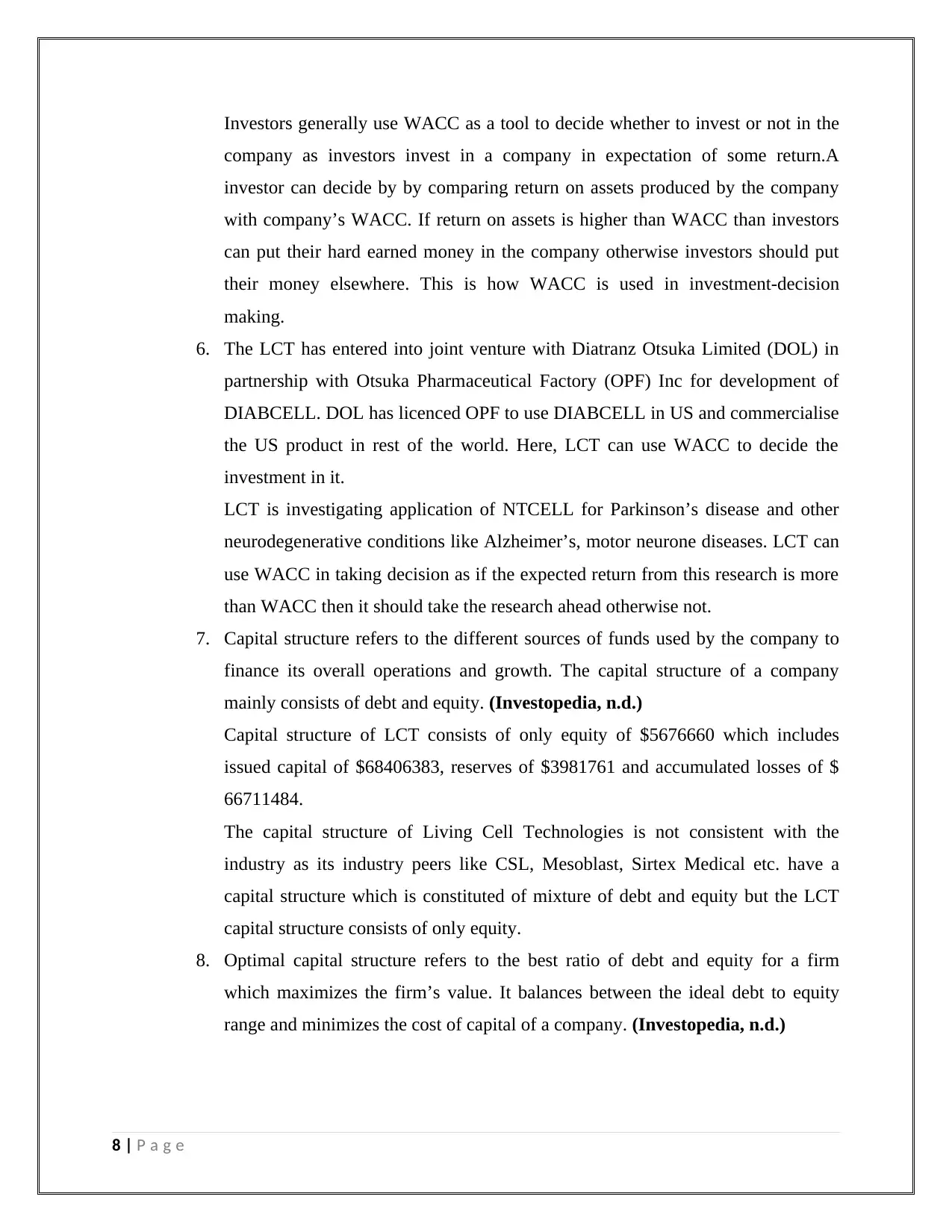
Investors generally use WACC as a tool to decide whether to invest or not in the
company as investors invest in a company in expectation of some return.A
investor can decide by by comparing return on assets produced by the company
with company’s WACC. If return on assets is higher than WACC than investors
can put their hard earned money in the company otherwise investors should put
their money elsewhere. This is how WACC is used in investment-decision
making.
6. The LCT has entered into joint venture with Diatranz Otsuka Limited (DOL) in
partnership with Otsuka Pharmaceutical Factory (OPF) Inc for development of
DIABCELL. DOL has licenced OPF to use DIABCELL in US and commercialise
the US product in rest of the world. Here, LCT can use WACC to decide the
investment in it.
LCT is investigating application of NTCELL for Parkinson’s disease and other
neurodegenerative conditions like Alzheimer’s, motor neurone diseases. LCT can
use WACC in taking decision as if the expected return from this research is more
than WACC then it should take the research ahead otherwise not.
7. Capital structure refers to the different sources of funds used by the company to
finance its overall operations and growth. The capital structure of a company
mainly consists of debt and equity. (Investopedia, n.d.)
Capital structure of LCT consists of only equity of $5676660 which includes
issued capital of $68406383, reserves of $3981761 and accumulated losses of $
66711484.
The capital structure of Living Cell Technologies is not consistent with the
industry as its industry peers like CSL, Mesoblast, Sirtex Medical etc. have a
capital structure which is constituted of mixture of debt and equity but the LCT
capital structure consists of only equity.
8. Optimal capital structure refers to the best ratio of debt and equity for a firm
which maximizes the firm’s value. It balances between the ideal debt to equity
range and minimizes the cost of capital of a company. (Investopedia, n.d.)
8 | P a g e
company as investors invest in a company in expectation of some return.A
investor can decide by by comparing return on assets produced by the company
with company’s WACC. If return on assets is higher than WACC than investors
can put their hard earned money in the company otherwise investors should put
their money elsewhere. This is how WACC is used in investment-decision
making.
6. The LCT has entered into joint venture with Diatranz Otsuka Limited (DOL) in
partnership with Otsuka Pharmaceutical Factory (OPF) Inc for development of
DIABCELL. DOL has licenced OPF to use DIABCELL in US and commercialise
the US product in rest of the world. Here, LCT can use WACC to decide the
investment in it.
LCT is investigating application of NTCELL for Parkinson’s disease and other
neurodegenerative conditions like Alzheimer’s, motor neurone diseases. LCT can
use WACC in taking decision as if the expected return from this research is more
than WACC then it should take the research ahead otherwise not.
7. Capital structure refers to the different sources of funds used by the company to
finance its overall operations and growth. The capital structure of a company
mainly consists of debt and equity. (Investopedia, n.d.)
Capital structure of LCT consists of only equity of $5676660 which includes
issued capital of $68406383, reserves of $3981761 and accumulated losses of $
66711484.
The capital structure of Living Cell Technologies is not consistent with the
industry as its industry peers like CSL, Mesoblast, Sirtex Medical etc. have a
capital structure which is constituted of mixture of debt and equity but the LCT
capital structure consists of only equity.
8. Optimal capital structure refers to the best ratio of debt and equity for a firm
which maximizes the firm’s value. It balances between the ideal debt to equity
range and minimizes the cost of capital of a company. (Investopedia, n.d.)
8 | P a g e
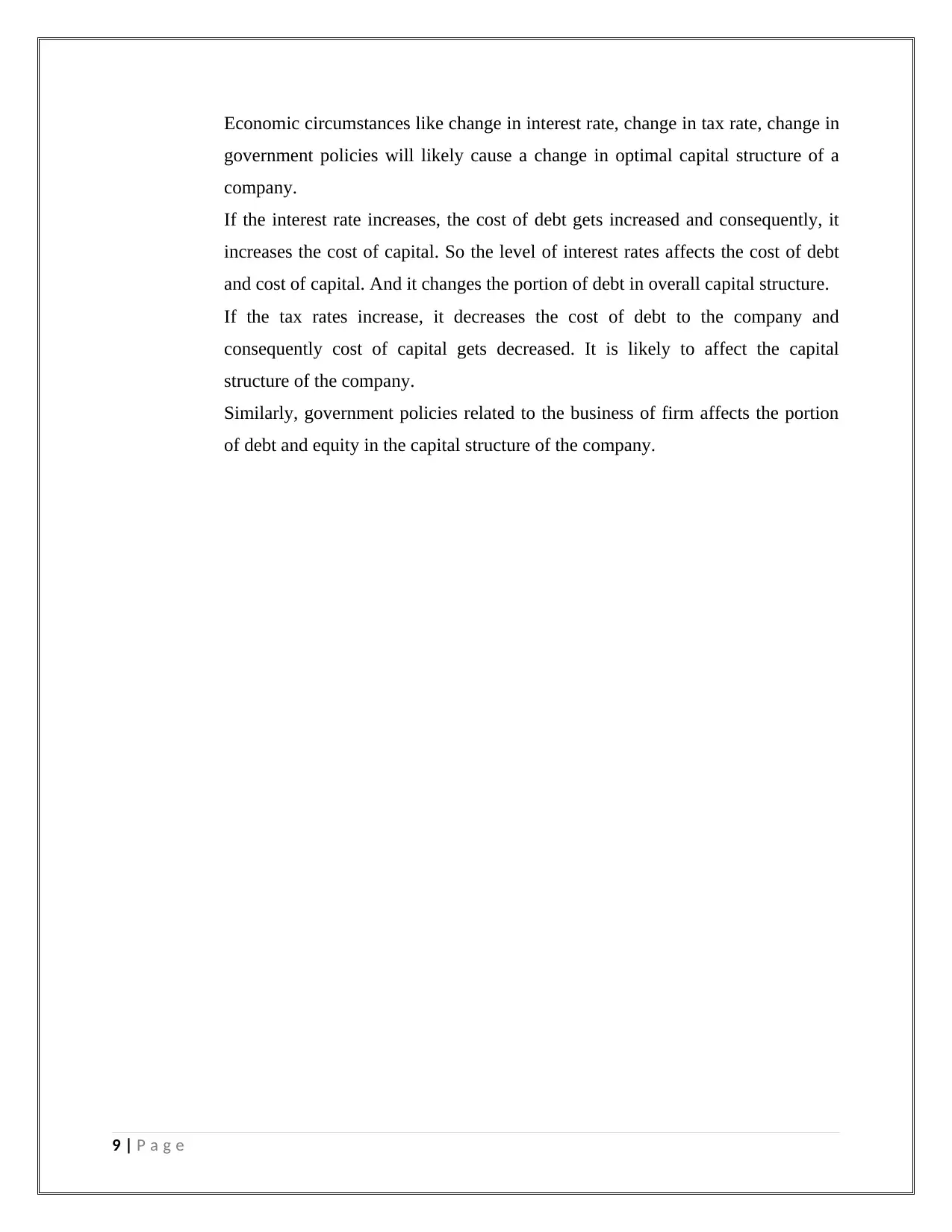
Economic circumstances like change in interest rate, change in tax rate, change in
government policies will likely cause a change in optimal capital structure of a
company.
If the interest rate increases, the cost of debt gets increased and consequently, it
increases the cost of capital. So the level of interest rates affects the cost of debt
and cost of capital. And it changes the portion of debt in overall capital structure.
If the tax rates increase, it decreases the cost of debt to the company and
consequently cost of capital gets decreased. It is likely to affect the capital
structure of the company.
Similarly, government policies related to the business of firm affects the portion
of debt and equity in the capital structure of the company.
9 | P a g e
government policies will likely cause a change in optimal capital structure of a
company.
If the interest rate increases, the cost of debt gets increased and consequently, it
increases the cost of capital. So the level of interest rates affects the cost of debt
and cost of capital. And it changes the portion of debt in overall capital structure.
If the tax rates increase, it decreases the cost of debt to the company and
consequently cost of capital gets decreased. It is likely to affect the capital
structure of the company.
Similarly, government policies related to the business of firm affects the portion
of debt and equity in the capital structure of the company.
9 | P a g e
⊘ This is a preview!⊘
Do you want full access?
Subscribe today to unlock all pages.

Trusted by 1+ million students worldwide
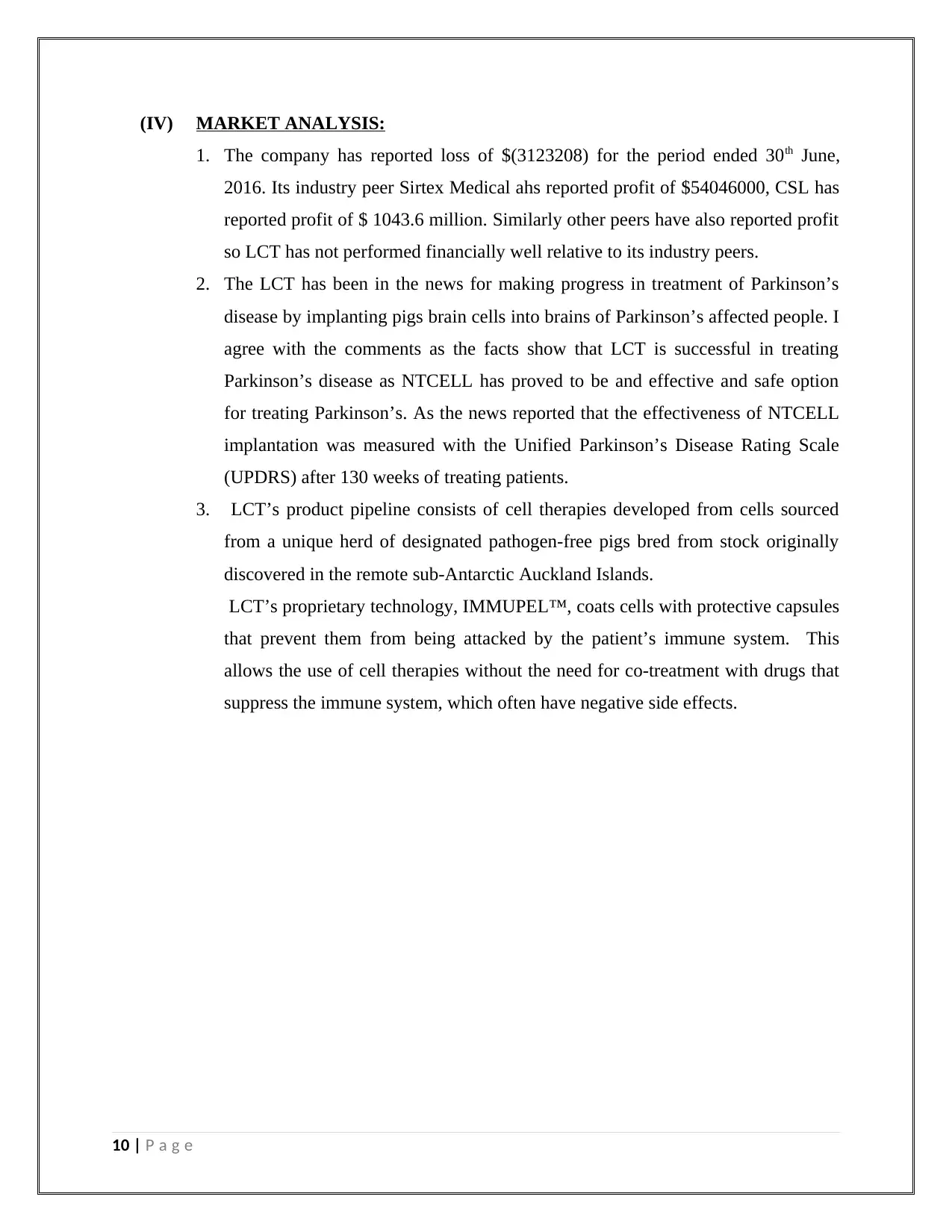
(IV) MARKET ANALYSIS:
1. The company has reported loss of $(3123208) for the period ended 30th June,
2016. Its industry peer Sirtex Medical ahs reported profit of $54046000, CSL has
reported profit of $ 1043.6 million. Similarly other peers have also reported profit
so LCT has not performed financially well relative to its industry peers.
2. The LCT has been in the news for making progress in treatment of Parkinson’s
disease by implanting pigs brain cells into brains of Parkinson’s affected people. I
agree with the comments as the facts show that LCT is successful in treating
Parkinson’s disease as NTCELL has proved to be and effective and safe option
for treating Parkinson’s. As the news reported that the effectiveness of NTCELL
implantation was measured with the Unified Parkinson’s Disease Rating Scale
(UPDRS) after 130 weeks of treating patients.
3. LCT’s product pipeline consists of cell therapies developed from cells sourced
from a unique herd of designated pathogen-free pigs bred from stock originally
discovered in the remote sub-Antarctic Auckland Islands.
LCT’s proprietary technology, IMMUPEL™, coats cells with protective capsules
that prevent them from being attacked by the patient’s immune system. This
allows the use of cell therapies without the need for co-treatment with drugs that
suppress the immune system, which often have negative side effects.
10 | P a g e
1. The company has reported loss of $(3123208) for the period ended 30th June,
2016. Its industry peer Sirtex Medical ahs reported profit of $54046000, CSL has
reported profit of $ 1043.6 million. Similarly other peers have also reported profit
so LCT has not performed financially well relative to its industry peers.
2. The LCT has been in the news for making progress in treatment of Parkinson’s
disease by implanting pigs brain cells into brains of Parkinson’s affected people. I
agree with the comments as the facts show that LCT is successful in treating
Parkinson’s disease as NTCELL has proved to be and effective and safe option
for treating Parkinson’s. As the news reported that the effectiveness of NTCELL
implantation was measured with the Unified Parkinson’s Disease Rating Scale
(UPDRS) after 130 weeks of treating patients.
3. LCT’s product pipeline consists of cell therapies developed from cells sourced
from a unique herd of designated pathogen-free pigs bred from stock originally
discovered in the remote sub-Antarctic Auckland Islands.
LCT’s proprietary technology, IMMUPEL™, coats cells with protective capsules
that prevent them from being attacked by the patient’s immune system. This
allows the use of cell therapies without the need for co-treatment with drugs that
suppress the immune system, which often have negative side effects.
10 | P a g e
Paraphrase This Document
Need a fresh take? Get an instant paraphrase of this document with our AI Paraphraser
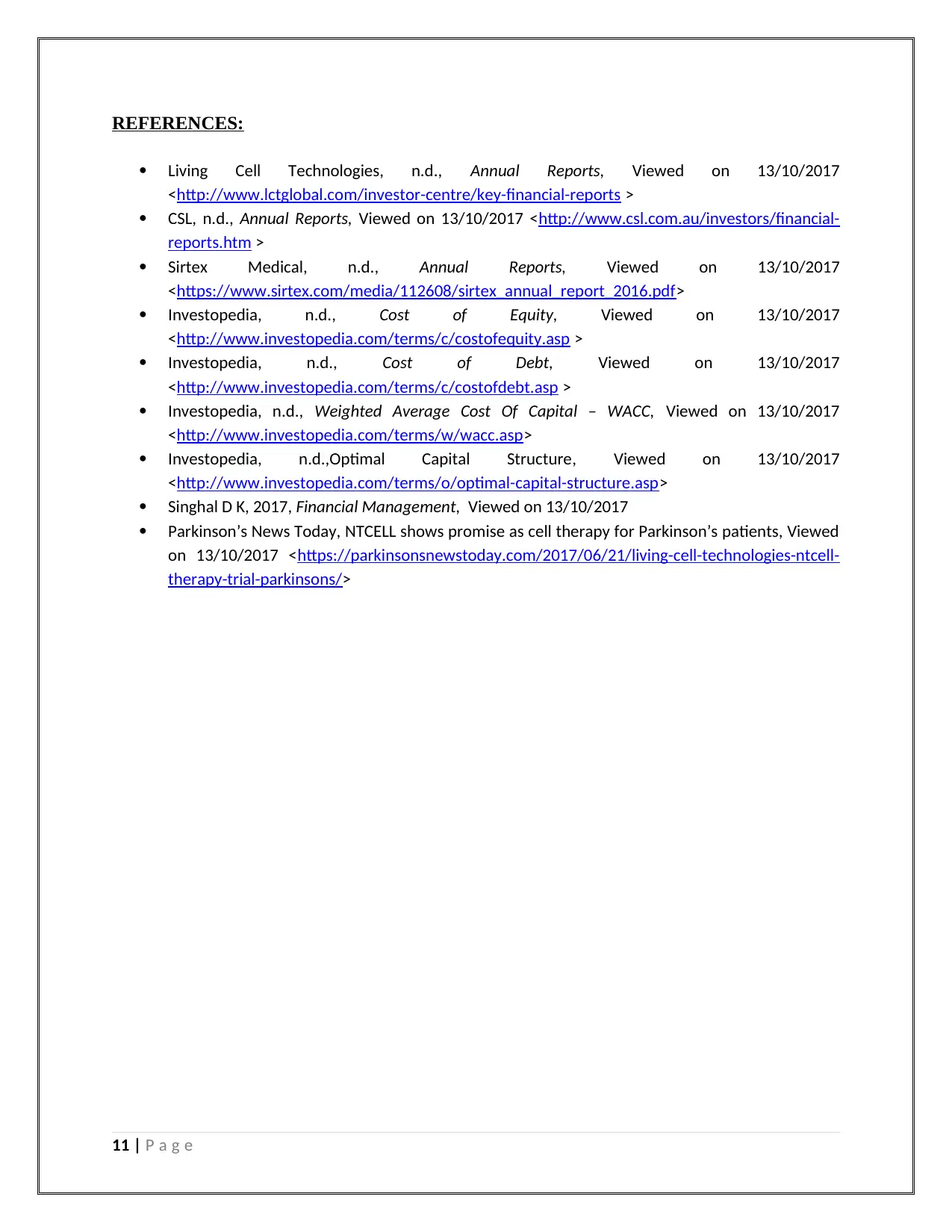
REFERENCES:
Living Cell Technologies, n.d., Annual Reports, Viewed on 13/10/2017
<http://www.lctglobal.com/investor-centre/key-financial-reports >
CSL, n.d., Annual Reports, Viewed on 13/10/2017 <http://www.csl.com.au/investors/financial-
reports.htm >
Sirtex Medical, n.d., Annual Reports, Viewed on 13/10/2017
<https://www.sirtex.com/media/112608/sirtex_annual_report_2016.pdf>
Investopedia, n.d., Cost of Equity, Viewed on 13/10/2017
<http://www.investopedia.com/terms/c/costofequity.asp >
Investopedia, n.d., Cost of Debt, Viewed on 13/10/2017
<http://www.investopedia.com/terms/c/costofdebt.asp >
Investopedia, n.d., Weighted Average Cost Of Capital – WACC, Viewed on 13/10/2017
<http://www.investopedia.com/terms/w/wacc.asp>
Investopedia, n.d.,Optimal Capital Structure, Viewed on 13/10/2017
<http://www.investopedia.com/terms/o/optimal-capital-structure.asp>
Singhal D K, 2017, Financial Management, Viewed on 13/10/2017
Parkinson’s News Today, NTCELL shows promise as cell therapy for Parkinson’s patients, Viewed
on 13/10/2017 <https://parkinsonsnewstoday.com/2017/06/21/living-cell-technologies-ntcell-
therapy-trial-parkinsons/>
11 | P a g e
Living Cell Technologies, n.d., Annual Reports, Viewed on 13/10/2017
<http://www.lctglobal.com/investor-centre/key-financial-reports >
CSL, n.d., Annual Reports, Viewed on 13/10/2017 <http://www.csl.com.au/investors/financial-
reports.htm >
Sirtex Medical, n.d., Annual Reports, Viewed on 13/10/2017
<https://www.sirtex.com/media/112608/sirtex_annual_report_2016.pdf>
Investopedia, n.d., Cost of Equity, Viewed on 13/10/2017
<http://www.investopedia.com/terms/c/costofequity.asp >
Investopedia, n.d., Cost of Debt, Viewed on 13/10/2017
<http://www.investopedia.com/terms/c/costofdebt.asp >
Investopedia, n.d., Weighted Average Cost Of Capital – WACC, Viewed on 13/10/2017
<http://www.investopedia.com/terms/w/wacc.asp>
Investopedia, n.d.,Optimal Capital Structure, Viewed on 13/10/2017
<http://www.investopedia.com/terms/o/optimal-capital-structure.asp>
Singhal D K, 2017, Financial Management, Viewed on 13/10/2017
Parkinson’s News Today, NTCELL shows promise as cell therapy for Parkinson’s patients, Viewed
on 13/10/2017 <https://parkinsonsnewstoday.com/2017/06/21/living-cell-technologies-ntcell-
therapy-trial-parkinsons/>
11 | P a g e
1 out of 11
Related Documents
Your All-in-One AI-Powered Toolkit for Academic Success.
+13062052269
info@desklib.com
Available 24*7 on WhatsApp / Email
![[object Object]](/_next/static/media/star-bottom.7253800d.svg)
Unlock your academic potential
Copyright © 2020–2025 A2Z Services. All Rights Reserved. Developed and managed by ZUCOL.





